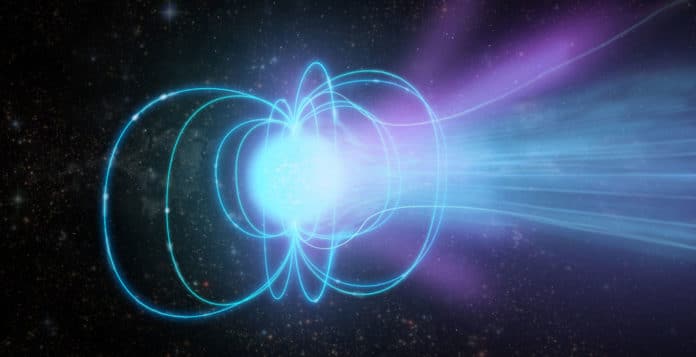Magnetars are a variety of neutron stars with powerful magnetic fields. A typical magnetar magnetic field is a trillion times stronger than the Earth’s magnetic field, making magnetars the most magnetic objects in the Universe. They can discharge strong bursts of X-rays and gamma rays, and recently have become a leading candidate for the sources of FRBs.
A magnetar called XTE J1810-197, discovered in 2003 was the first of only six such objects to emit radio pulses. It did so from 2003 to 2008, then ceased for a decade. In December of 2018, it resumed emitting bright radio pulses.
Now, astronomers used the National Science Foundation’s Very Long Baseline Array (VLBA) to measure the first direct geometric measurement of the distance to a magnetar.
Using VLBA, astronomers regularly observed the magnetar from January to November of 2019, then again during March and April of 2020.
By viewing the magnetar from opposite sides of the Earth‘s orbit around the Sun, they identified a slight shift in its apparent position regarding background objects considerably more removed. This impact, called parallax, permits cosmologists to utilize geometry to ascertain the object’s distance directly.
Hao Ding, a graduate student at the Swinburne University of Technology in Australia, said, “This is the first parallax measurement for a magnetar. It shows that it is among the closest magnetars known—at about 8100 light-years—making it a prime target for future study.”
Adam Deller, also of Swinburne University, said, “Having a precise distance to this magnetar means that we can accurately calculate the strength of the radio pulses coming from it. If it emits something similar to an FRB, we will know how strong that pulse is. FRBs vary in their strength, so we would like to know if a magnetar pulse comes close or overlaps with the strength of known FRBs.”
Walter Brisken, of the National Radio Astronomy Observatory, said, “A key to answering this question will be to get more distances to magnetars, so we can expand our sample and obtain more data. The VLBA is the ideal tool for doing this.”
Ding said, “We know that pulsars, such as the one in the famous Crab Nebula, emit ‘giant pulses,’ much stronger than their usual ones. Determining the distances to magnetars will help us understand this phenomenon, and learn if maybe FRBs are the most extreme example of giant pulses.”
Journal Reference:
- H Ding et al. A magnetar parallax, Monthly Notices of the Royal Astronomical Society (2020). DOI: 10.1093/mnras/staa2531
